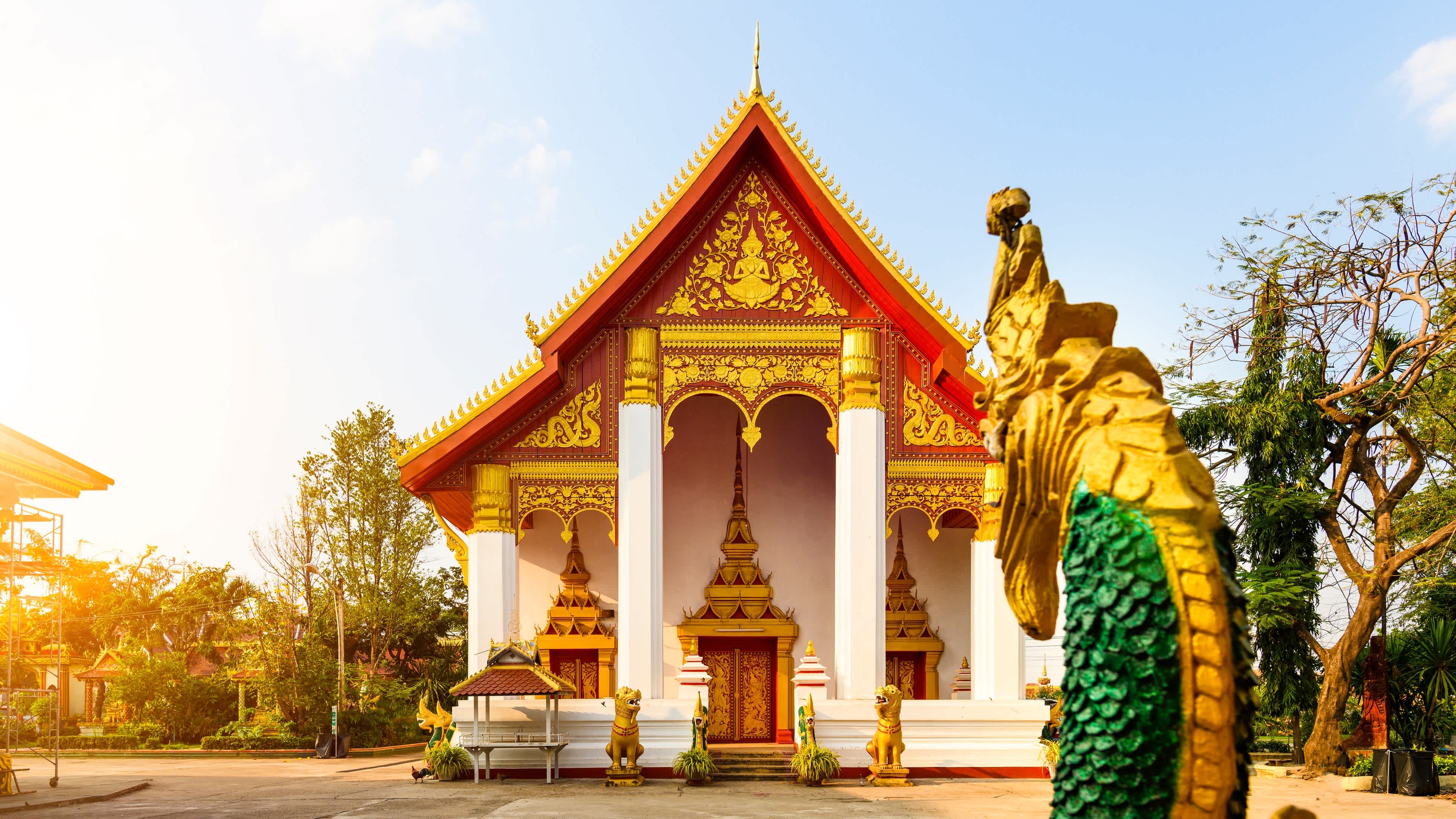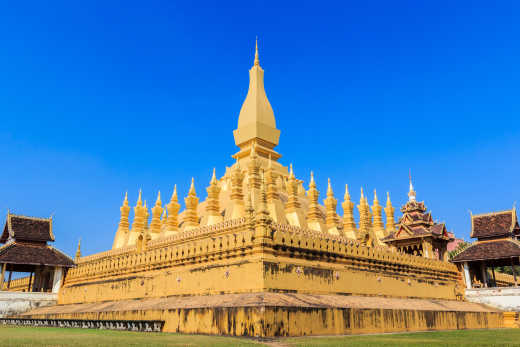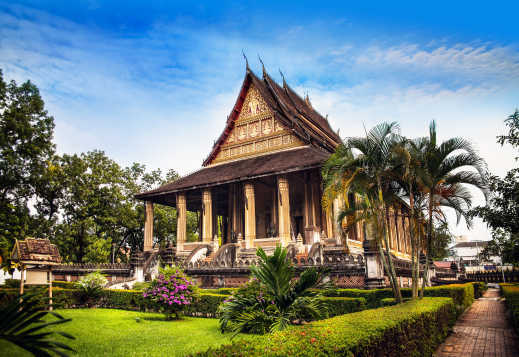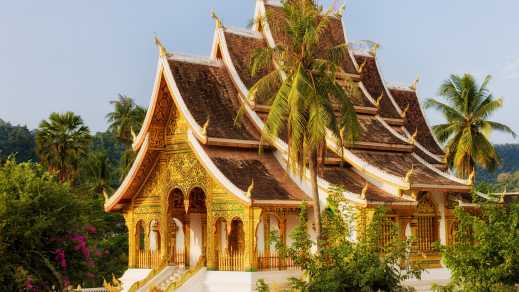
Vientiane Tours
The top sights, highlights, tours & travel itinaries curated by our Travel Experts.
- Destinations
- Asia
- Laos
- Vientiane
Our Expert Tips for Your Vientiane Tour
Magnificent stupas, colourful temples, French colonial buildings and shady parks in between - in Vientiane you will dive deep into the history of Laos as well as the Buddhist past and present of the country. Shimmering gold facades, giant Buddha statues and fragrant marketplaces demand the full attention of your senses.
Roam the massive temple complex of Pha That Luang and take in the breathtaking panorama from Laos' "Arc de Triomphe". Vientiane is a veritable cornucopia for experiencing Lao art and daily life first hand: Welcome to the "City of the Moon"! Less
![Asia Laos Vientiane Pha That Luang Vientiane Pha That Luang]()
Pha That Luang
The landmark of the city
![Asia Laos Vientiane Patuxai Vientiane Patuxai]()
Patuxai
An imposing triumphal arch
![Asia Laos Vientiane That Dam Vientiane That Dam]()
That dam
A mystical monument
What to See During Your Vientiane Tour?
1. Pha That Luang
Shining in gold, the Pha That Luang is a three-storey stupa that is the landmark of Laos. Just stroll north from the city center - the opulent structure will show you the way from afar. In front of the stupa, enthroned on a pedestal, is the statue of King Setthathirat, who moved the capital from Luang Prabang to Vientiane in the 16th century. It was he who designed the stupa's present familiar shape. As the center of Lao Buddhism, Pha That Luang was lined with four other temples (wat) in each cardinal direction. Two of them are still standing: You will encounter probably one of the most famous Lao Buddhas in Wat That Luang Thai. Here a huge, golden Buddha statue rests in a reclining position.
2. Wat Si Saket
You may see it right at first glance: Wat Si Saket stands out from the other temples and stupas in Vientiane. This is because the temple was built in the Siamese style - not the Lao style. Almost all temple complexes fell victim to the war against Siam. Only Wat Si Saket was spared by the Siamese. Today, the oldest temple of the city houses the museum "Si Saket", where you can admire numerous artistically crafted Buddha statues. Particularly striking is the elaborately constructed Chinese drum tower. The complex is a small, self-contained paradise where you can stroll and linger. Meanwhile, watch monks perform their daily rituals from a respectful distance. A very tranquil experience on your Vientiane trip.
3. Wat Si Muang
The golden center of Vientiane: Wat Si Muang is supposed to mark the center of the Laotian capital. In reality, it is located to the east of the center. The "pillar of the city" is a Buddhist temple, colourful and decorated in gold, which plays an important role for Buddhist pilgrims. Unusually for a Wat, the temple is divided into two rooms: In the demand, rather sparse room, a monk blesses each visitor upon request. The back section houses a massive and beautiful shrine. Here you can lay offerings such as fruit, money or candles. Believers promise themselves eternal luck and fulfilled wishes. In the outer area you can marvel at countless golden Buddha statuettes and other shrines. Wat Si Muang is a small wonder in the middle of a lively city.
4. Patuxai
Patuxai is a triumphal arch in Vientiane that closes off the boulevard Xang. The concrete monument is a proud 49 meters high: for a small entrance fee, you can enter the upper floor of the Patuxai and enjoy a wonderful view over the city. The "Arc de Triomphe" is dedicated to the fallen of the wars of liberation. Its construction was never really completed. Nevertheless, the Patuxai exudes a certain aura that seems powerful and venerable. Around it runs a symmetrical park, which is especially popular with locals. People gather here, relax in the balmy evening hours and watch the colorful water feature in the park accompanied by music. You can buy a souvenir from one of the souvenir shops inside the four-gate arch.
5. Haw Phra Kaew
A stone's throw away from Wat Si Saket is the Haw Phra Kaew. The former temple once stood on the grounds of King Setthathirath's royal palace. Haw Phra Kaew had a single function: the massive structure provided a suitable home for the world-famous Jade Buddha. However, the Buddah statue was captured during a war. Today Haw Phra Kaew is a museum, displaying numerous Buddha figures in all sizes, materials and representations. Whether seated, reclining, made of bronze, stone or wood, if you want to learn more about Buddhism and Lao arts and crafts, don't miss a visit to Haw Phra Kaew on your Vientiane trip. One of the two-thousand-year-old jars from the "Plain of Stone Jars" at Phonsavan rests in the beautiful grounds.
6. That Dam
Be on your guard when visiting That Dam, the "Black Stupa." A seven-headed dragon is said to dwell under this mystical monument, according to legend. It was he who was supposed to protect Vientiane from enemy attacks during the war against Siam. The once golden stupa has fallen victim to weathering and vegetation. That Dam was restored in 1995, but thereafter left to repeated decay. Still, it's worth a visit to the fabled monument. Here you will experience the history of the Lao capital first hand. You will feel how facts and legends give this place a special meaning. Not far from That Dam is the Talat Sao morning market, where you can shop for specialties and souvenirs to your heart's content.
7. Thai-Lao Friendship Bridge
A special highlight is a visit to the first Thai-Lao Friendship Bridge. It is a worthwhile extra that you can easily integrate into a city visit. It is best to use a shuttle bus or a taxi. After a short drive, you will reach the Friendship Bridge on the lower reaches of the Mekong River. It is a historical testimony to the friendly bond between Laotians and Thais. The 0.7 mile concrete bridge connects Vientiane and Bangkok directly. When it opened in 1994, it was only the second bridge ever to span the Mekong River. The bridge is a popular sight among travellers - not because of its beauty, but all the more because of its peacemaking significance. Less
Other Places to Visit During Your Tour
TourlaneCare





